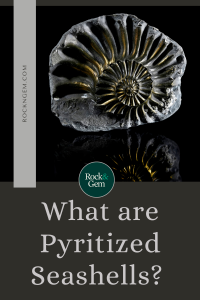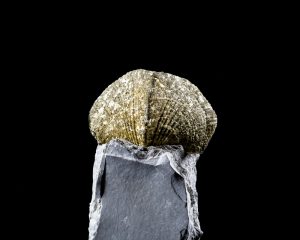
What are pyritized seashells? How do you find them? Such a fantastic find, once it is cleaned, can exhibit spectacular arrays of sparkling pyrite crystals and become a golden treasure.
How Does a Fossil Become Pyritized?
Once a marine creature dies and is buried by sediments, generally storm deposits, it begins its transformation from a normal seashell to a pyritized beauty.

When a fossilized shell is pyritized, the original calcite shell is replaced microscopically by filling the cellular spaces with minerals, in this case, iron pyrite. Organisms may become pyritized when they are in marine sediments that are saturated with iron sulfides. (Pyrite is iron sulfide.) As organic matter decays it releases sulfide which reacts with dissolved iron in the surrounding waters. Pyrite replaces the carbonate shell material because of an undersaturation of carbonate minerals in the surrounding waters.
What is a Brachiopod?
Brachiopods are marine bivalve mollusks. A mollusk is a soft-bodied invertebrate animal with hard external calcium carbonate shells called “valves.” Commonly they are called seashells or lamp shells because of the shape of the valves. Although most brachiopods are extinct, a few may still be found around the world.
The word brachiopod comes from ancient Greek, “brachion” meaning arm and “podos” meaning foot. Brachiopods have a large muscular “foot” they use to anchor themselves to the seafloor.
Brachiopods arrived on the scene during the Silurian period and most ranged through to the Carboniferous period. When found in deposits they are generally abundant. There are a few locations where the sediments contain millions upon millions of fossilized brachiopods.
The outer shells have many fine ridges called costae, running from the bottom or back of the shell to the front. Brachiopods have hinged shells at the top and bottom, clams have a hinge with a left and right arrangement.
 Some brachiopods are “inarticulate” and do not possess hinges, but most have a “stalk-like” pedicle or foot that projects from an opening in the bottom valve. That pedicle keeps the animal anchored to the seafloor.
Some brachiopods are “inarticulate” and do not possess hinges, but most have a “stalk-like” pedicle or foot that projects from an opening in the bottom valve. That pedicle keeps the animal anchored to the seafloor.
Paraspirifer Bownockeri
One of the most famous brachiopods is from northern Ohio called the parsapirifer bownockeri. These are getting harder and harder to find…especially pyritized.
The Devonian Silica Shale from Lucas County in Northwestern Ohio produces many kinds of brachiopods and some are bedazzled with pyrite crystals. The bownockeri species is a large brachiopod reaching a maximum of three inches in length. It is believed to have inhabited shallow mudflats.
Sitting on its pedicle valve, it was a filter feeder filtering the water for bits of floating plankton and detritus.
The Silica Shales of Lucas County, especially near the city of Sylvania, are well known for pyritized fauna such as paraspirifers, Atrypa brachiopods and bryozoans. Many of these golden beauties reside in older collections. They are no longer readily available as the quarries have shut down or have denied access because of mining regulations or fears of litigation. It is sometimes still possible to purchase these in local rock shops and rarely at rock shows.
This story about pyritized seashells appeared in Rock & Gem magazine. Click here to subscribe. Story by Joseph “PaleoJoe” Kchodl.














